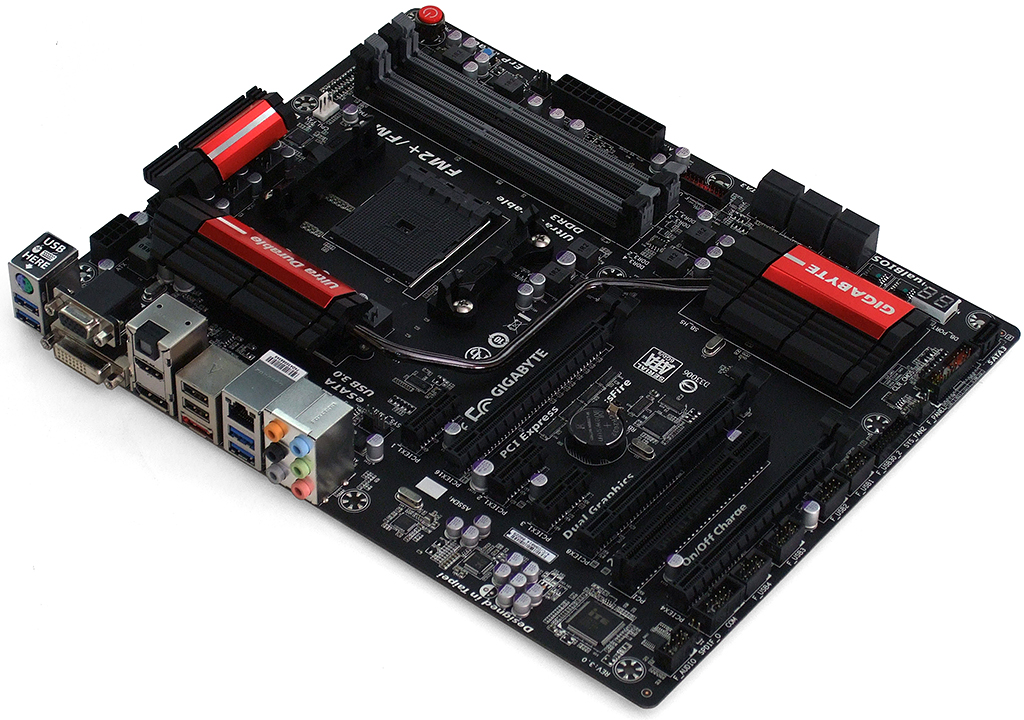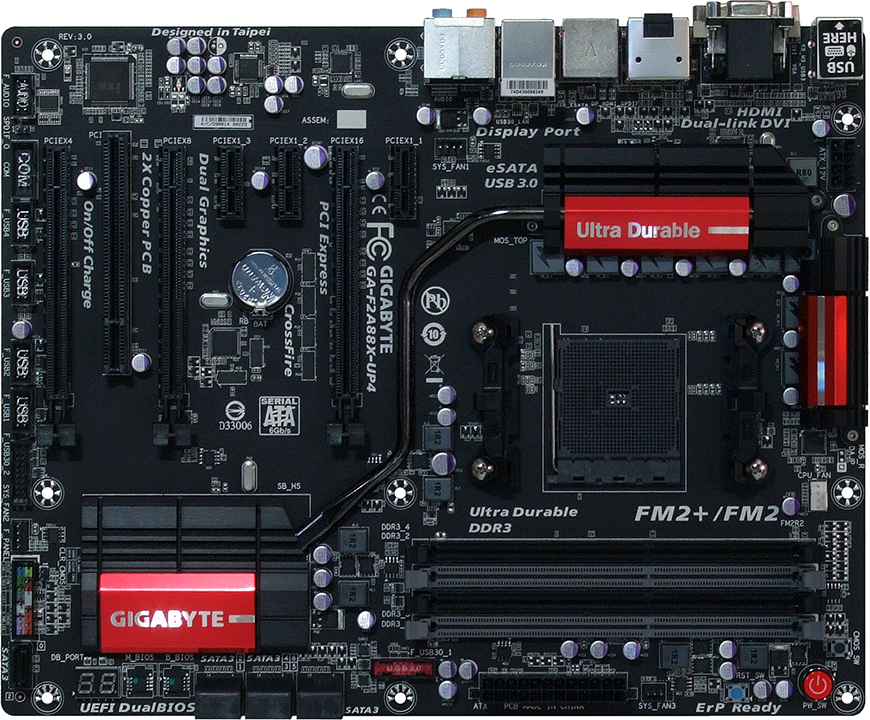Which A88X-Based Board Should You Buy For Your Kaveri APU?
Gigabyte F2A88X-UP4
The second motherboard in today’s round-up with support for up to three PCIe x16 cards, Gigabyte’s F2A88X-UP4 combines an older ALC892 audio codec with a couple of extra front-panel USB 3.0 ports to attract buyers with different priorities. At $105, it’s also a little cheaper than the competing A88X-Pro.
Gigabyte scales its I/O panel down to a single eSATA port, but keeps the DisplayPort feature of its more expensive rival. This board also retains the outdated VGA connector, employs an eight-phase CPU power regulator, and includes a Port 80 diagnostics display. And that missing eSATA connector is instead found as an internal SATA port.
Up until this point, Gigabyte’s feature set appears on par with what Asus offers, and at slightly lower cost. But Gigabyte also attempts to boost value by adding two BIOSes, a firmware selector button, a power button to ease open-air testing, and a reset button for the same purpose.
Not all of the F2A88X-UP4’s features are available to all configurations, though. For example, the second front-panel USB 3.0 header is located beneath the bottom graphics card slot, and associated cables are too stiff to tuck under a graphics cooler. Populating one means losing the other. The seventh SATA connector could have similar issues, but only if your third graphics card is particularly long.
Furthermore, the bottom slot, wired up to four lanes, gets kicked down to x1 mode whenever a card is installed into the third PCIe x1 slot. We’re not sure why the firm didn’t share that interface with the middle PCIe x1 slot, or even eliminate the second x1 slot entirely and use its lane for the third slot, since any slot under the primary graphics card inevitably gets blocked by a heat sink and fan.
The front-panel audio header presents the only other installation difficulty; the cables of some cases are around half of an inch too short to reach the bottom-rear corner. We realize that most companies have placed this header there for years, but several chassis vendors continue shipping shorter leads. Many competing motherboard designs move their connectors forward slightly to compensate.
Imagining that your case has a long FP-Audio cable, that you don’t plan to use the seventh SATA header, you never plan to install a card into the third PCIe x1 slot, and you don’t have a second front-panel USB 3.0 breakout cable to install, the F2A88X-UP4 could be a great platform for dropping a trio of GPUs into for general-purpose computing. That's going to be an incredibly rare combination, though. If we instead treat the F2A88X-UP4 as a solution for up to two graphics cards, its layout similarly approaches perfection.
Get Tom's Hardware's best news and in-depth reviews, straight to your inbox.
Gigabyte sets high standards for out-of-the-box SATA support, providing six internal cables for its seven-port F2A88X-UP4.
Current page: Gigabyte F2A88X-UP4
Prev Page Additional AI Suite 3 Tools Next Page F2A88X-UP4 Firmware-
gadgety To me the point of Kaveri is great graphics in a small package, thus the MB would have to be as small as possible. M-ITX is currently the smallest. Someone should bring out a NUC sized board for the Kaveri.Reply -
blackmagnum On the other side of the fence... Haswell+ Maxwell= performance/watt/buck. You're welcome.Reply -
ta152h The IO device is called PS/2, not P/S 2. It stands for Personal System/2, the IBM product line from 1987. Also, there's a chance there's a big performance gain from Catalyst 14.2, instead of 14.1. Another site did benchmarks comparing 13.6 and 14.2, and the difference was dramatic. It most likely was the somewhere in the 13.6 to 14.1 range, though. I thought the days of one motherboard having significantly faster memory timings than the other died with the IMCs. After being shocked at the horrible performance of the Kaveri, and the almost complete failure of it, between the driver update, and advantage the Asus has, it's clear AMD pulled another "Hawaii", and put their technology in the worst possible light by not packaging it with the proper associated support technologies. Considering the long development cycles for these devices, it's hard to understand how AMD couldn't figure out a proper cooler for the Hawaii, or have drivers degrade performance so much for Kaveri, that within a month or so they were able to increase performance so dramatically. And now, it's clear the memory performance optimizations were far from complete. And Kaveri was a delayed product. It boggles the mind that they consistently fail to find such obvious shortcomings, when everyone else finds them pretty quickly. Clearly, their testing procedures need serious revision in scope.Reply -
ferooxidan "To me the point of Kaveri is great graphics in a small package, thus the MB would have to be as small as possible. M-ITX is currently the smallest. Someone should bring out a NUC sized board for the Kaveri."No, the best NUC will be Haswell + Maxwell, period.Reply -
almarcy Thank you for a useful grid of the current products. I am migrating from my current dinosaur. I am not at all interested in smaller, sleeker, tighter. Just faster. ~4 GHz with 2.4 GHz DDR3 for under $500. seems pretty irresistible :)Reply -
Someone Somewhere Can we see some benchmarks on the Killer card vs other competitors? It feels like FUD to me.Reply -
beerdette "No, the best NUC will be Haswell + Maxwell, period."The point of Kaveri on a NUC would be not to have the space that a graphics card takes. So it wouldn't be the best NUC because then you need to add space for that card.Reply -
de5_Roy Reply
yes. but at a lower price range probably. first, a10 7850k itself has to come down in price by $40-50 outside microcenter.12925440 said:Is anyone actually going to buy an ATX Kaveri motherboard?
-
vertexx Reply12925643 said:
yes. but at a lower price range probably. first, a10 7850k itself has to come down in price by $40-50 outside microcenter.12925440 said:Is anyone actually going to buy an ATX Kaveri motherboard?
Even beyond price, ATX seems pointless with a Kaveri APU. Myself, I'm waiting for the A8-7600 to build a very small (< 3 liters) ITX HTPC running the APU in 45W mode. Although I'm very excited about doing that build, I can't see any use case that makes sense for a Kaveri APU in an ATX form factor. Perhaps the A88x chipset has some feature benefit for building something using the 750 or 760k CPU in a budget build. But the only build I would even think about using a Kaveri APU in would be a mini-ITX PC/HTPC or laptop.
Beyond that, I would love to see Lian-Li come out with a tiny case like the PC-Q02, PC-Q09 or PC-Q12, but with the design for a single 120mm CLC and a 300W SFX PSU to allow a decent overclock on a 7850k APU with the smallest form factor possible (i.e. < 8 liters). That type of build might get me jazzed up for the 7850k.



